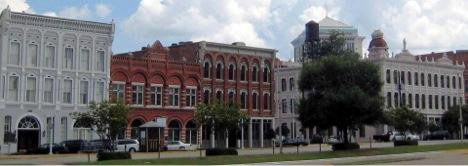
A white Ford truck with a Confederate flag rolls down Commerce Street, also known as the slave transport route from the train station by the river to the slave market on the corner of S. Court and Dexter Ave. We walk into the Equal Justice Initiative’s base of operations in downtown Montgomery. It is haunted by the country’s worst moment in history. EJI’s building, a former slave depot where Blacks were auctioned off like land and livestock, now serves to “provide legal representation to indigent defendants and prisoners who have been denied fair and just treatment in the legal system.” Led by Bryan Stevenson, EJI looks to change the way people think about race and poverty, children in prison, mass incarceration, and the death penalty in the United States.

Slavery in America lasted for more than two centuries, creating a political, economic, legal, and social system that overwhelmingly harms people of color to this day. This system later re-formed into Jim Crow laws and the idea of separate but equal, while allowing for white supremacist groups to terrorize Blacks around the country, especially in the South. In these former slave states, thousands of lynchings occurred traumatizing Blacks around the country. Millions of African Americans fled this violence by traveling North in what became known as the Great Migration. Today the United Nations would consider these migrants to be internally displaced people because they were fleeing violence in their own country.A few decades later, the Civil Rights Movement was in full swing. Bus boycotts in Montgomery, sit-ins in Greensboro, desegregation of schools, freedom rides, voting registration, the march from Selma to Montgomery, and the March on Washington all led to crucial legislation including the Civil Rights Act of 1964, the Voting Rights Act of 1965, and the Fair Housing Act of 1968. However, in resistance to progress, some Southern states flew the Confederate flag over their capitals, igniting a false sense of heritage and further discrimination.
Contrary to many historical texts taught in primary school, the limitations on people of color did not stop after the Civil Rights Movement. Some would argue that the system of slavery has only reinvented itself to new ways of harming people of color. One in three of all African American men will end up in jail sometime in their lifetime thus losing the right to vote in future elections. Black men are six times more likely to be incarcerated than white men for the same crime largely as a result of the “War on Drugs” that targets low income people and minorities. The new attention to police brutality, which has occurred for decades, has resulted in the Black Lives Matter social movement, stating that Blacks are still not treated equally under the law. A former SNCC member that we spoke with stated that it’s like the Ku Klux Klan took off the white robes and put on police uniforms instead. Furthermore, states across the South are changing voting rights by adding amendments, like requiring photo IDs, making it more difficult for low income families and minorities to vote.

Here in Lowndes County the centuries of structural inequality are evident in the fact that many rural, low income, Black families do not have equal access to sewer systems. For example, formerly white neighborhoods of Lowndes County had six-inch sewage pipes installed while black neighborhoods only received three-inch pipes, causing septic tanks to break, back up, and overflow. The county continues to receive money and grants that are able to temporarily fix the problems but when a system is installed using discriminatory practices, there is no quick fix. When something is wrong from the foundation, it cannot simply be patched up. Access to water and proper sanitation are basic human rights that are not being met, here, in the 21st Century in the United States of America. People of color are still hurting from a system of white supremacy that has continuously been revived in new iterations. We need a new foundation.